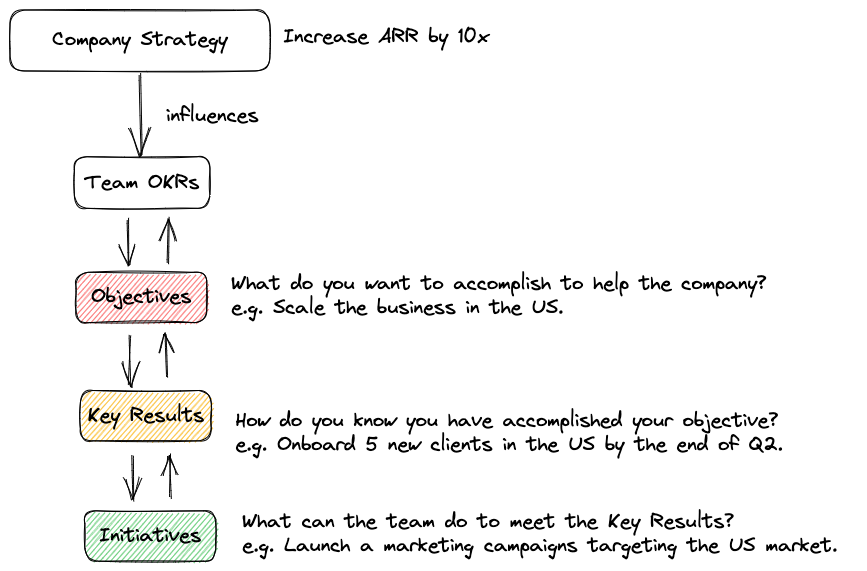As a manager, I spend a reasonable amount of time setting OKRs for my team every quarter. Therefore I am writing this article to explain the OKR framework and clarify how to set practical and clear OKRs that contribute to the company strategy.
What are OKRs?
OKRs stands for Objectives and Key Results, a framework that helps the company/teams/individuals define measurable goals and track outcomes. Besides, the name only mentions Objectives and Key Results. In practice, there are three distinct components:
Objective
The objective is a direction on what you want to improve aligned with the company mission. It should be inspirational, clear and easy to understand.
Examples
- Business: Expand the business in the US.
- Engineering: Increase the quality of the product.
- Personal: Become more confident with your own body.
Key Results
Key Results are quantitative metrics that help track progress toward achieving the objective. They must be measurable, challenging yet achievable, and time-bound. A good Key Result must focus on the outcome rather than the output. For example, a team can deliver multiple features, but they are not achieving the expected outcome if they don’t positively impact customers.
Examples
Business:
- Sign five new contracts with clients from the US by the end of Q2.
- Increase the signup conversion by 5% from 55% to 60% by the end of Q2.
Engineering:
- Increase the test coverage of the product API from 50% to 90% end of Q2.
- Reduce the incidents by 80% from 10 to 2 by the end of Q2.
Personal:
- Lose weight from 80kg to 75kg by the end of Q2.
- Run 100km by the end of Q2.
Initiatives
Initiatives are tasks/projects that drive the metrics to achieve the key results.
Examples
Business:
- Launch a marketing campaigns targeting the US market.
- Create an A/B testing on the signup page to test the new UI.
Engineering:
- Enable autoscaling to handle traffic spikes.
- Organise a workshop about the different testing strategies.
- Update the PR review approval process to check for coverage.
Personal:
- Prepare your food for the week every Sunday.
- Go for a run every two days.
Overview

Tips for setting good OKRs
-
To define good OKRs, the company must have a clear strategy. Otherwise, how can you set clear OKRs to help the company? Work together with your manager and leadership team to understand what is the direction of the company.
-
When defining OKRs, I recommend using a bottom-up approach. So each team can determine the best OKRs to contribute to the overall company strategy. During the process of defining the OKRs, involving the whole team, PM, EM, and engineers is essential to set better OKRs since each individual can contribute ideas and understand potential dependencies between teams, leading to a culture of fostering ownership, alignment, better engagement and performance.
-
Setting OKRs for the first time can be intimidating, especially with no historical context. In this case, avoid quantitative metrics when defining Key Results and phrase it as benchmarking metric X. The idea is to benchmark a specific metric during the current quarter for a more precise number in the following months. This approach is more realistic than a total estimation guess that provides little value.
-
After setting the OKRs, we must monitor the status throughout the quarter and not only at the end. I like using a tool (it can be a spreadsheet) where everyone in the company can view the progress. An effective way to update the status is to involve the whole team. In my team, the person facilitating the sprint is responsible for reviewing and updating the OKRs. Sharing gives a sense of responsibility and helps with prioritising. For example, when deciding to work on task A over B, they will consider which task contributes the most to achieving the OKRs.
To summarise, combining OKRs with initiatives is a powerful approach for organisations to achieve their goals. By breaking down objectives into specific initiatives, this method provides a clear roadmap for success and enables organisations to prioritise and track progress effectively. Even though most examples in this article are mainly in the business world, you can use the OKRs framework to set personal objectives and improve yourself.